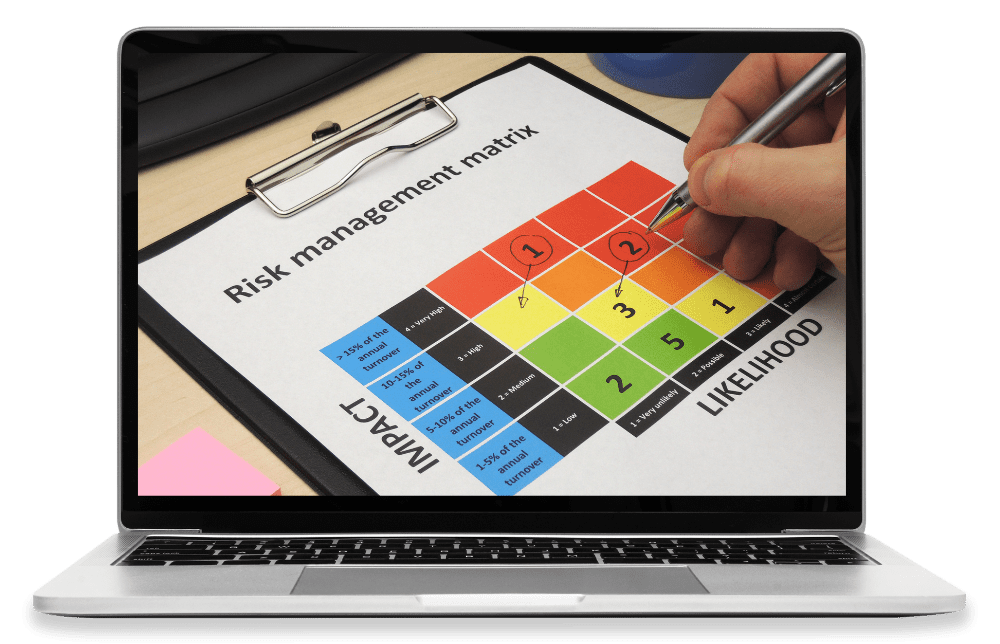Enhance your risk assessment capabilities with customisable risk matrix templates
The customisable risk matrix templates offered by SECTARA can help you tailor your risk assessment process to meet your specific needs and protect your organisation from various security risk vectors.
Enhance your risk assessment capabilities with customisable risk matrix templates
The customisable risk matrix templates offered by SECTARA can help you tailor your risk assessment process to meet your specific needs and protect your organisation from various security risk vectors.
Why choose customisable risk matrix templates?

No two organisations are alike—even if they operate within the same industry—which means that the risk vectors they’re exposed to are also unique and varied, calling for a more tailored approach to risk assessments
Having a rigid risk assessment workflow that doesn’t consider the unique circumstances of an entity opens the door to inefficiencies in the risk management process, which can ultimately lead to disruptions to operations, reputation damage, and legal ramifications
This makes having a customisable risk matrix template all the more important, as it allows organisations to be flexible with their risk assessment workflows and tailor their risk assessments to fit their unique requirements and circumstances
How to customise a risk matrix?
Risk matrices give organisations a holistic view of their risks based on three factors; the severity of a risk, the likelihood of the risk impacting the business, and the level of risk impact
There are five levels of risk severity—negligible, minor, moderate, major, and catastrophic— and five levels of risk likelihood—very likely, probable, possible, not likely, and very Unlikely
Organisations can customise the criteria that are used to assign risks — a risk severity and likelihood rating based on their circumstances. Some risk assessment platforms also allow risk assessment personnel to add their own descriptions to the risk matrix fields and even enable additional risk impact fields to be added


Risk matrices give organisations a holistic view of their risks based on three factors; the severity of a risk, the likelihood of the risk impacting the business, and the level of risk impact
There are five levels of risk severity—negligible, minor, moderate, major, and catastrophic— and five levels of risk likelihood—very likely, probable, possible, not likely, and very Unlikely
Organisations can customise the criteria that are used to assign risks — a risk severity and likelihood rating based on their circumstances. Some risk assessment platforms also allow risk assessment personnel to add their own descriptions to the risk matrix fields and even enable additional risk impact fields to be added
How to use a risk matrix?
Identify risks
Create a list of potential risks that could affect your organisation based on the industry and scope of your operations.
Determine the severity of risks
Once you have the list of risks ready, assign it a severity score from 1-5 based on the severity criteria you’ve defined.
Identify the likelihood of risks
Give a likelihood score from 1-5 for all the identified risks. Collaborate with your team to determine the likelihood.
Identify risks
Create a list of potential risks that could affect your organisation based on the industry and scope of your operations.
Determine the severity of risks
Once you have the list of risks ready, assign it a severity score from 1-5 based on the severity criteria you’ve defined.
Identify the likelihood of risks
Give a likelihood score from 1-5 for all the identified risks. Collaborate with your team to determine the likelihood.
Calculate risk impact
You can calculate the risk impact of each risk vector by multiplying the severity score and likelihood score.
Prioritise risks and take action
Allocate resources to address risks based on the risk impact score. Risks with the highest scores require priority attention.
Calculate risk impact
You can calculate the risk impact of each risk vector by multiplying the severity score and likelihood score.
Prioritise risks and take action
Allocate resources to address risks based on the risk impact score. Risks with the highest scores require priority attention.
Transform risk assessments with SECTARA
As risk management professionals, we understand the importance of a capable and feature-rich risk assessment platform.
That’s why we built SECTARA, a risk management software that offers organisations collaborative tools to produce professional risk assessments and treatment plans that align with global risk management standards. We also guarantee data integrity with military-grade encryption.
Want to experience how SECTARATM works first-hand?
Sign up for our 14-day free trial today
Start your 14-day free trial
What you get with our free trial
2 users (Account Admin, Org & BU Admin, Assessor, Viewer)
2 concurrent assessments
2 organisations & business units
In product training
The ability to export assessments to MS Word
MS Excel treatment plans
White label SECTARATM platform
White-label exported documents
Audit records
Want to experience how SECTARATM works first-hand?
Sign up for our 14-day free trial today
What you get with our free trial
2 users (Account Admin, Org & BU Admin, Assessor, Viewer)
2 concurrent assessments
2 organisations & business units
In product training
The ability to export assessments to MS Word
MS Excel treatment plans
White label SECTARATM platform
White-label exported documents
Audit records
Start your 14-day free trial








